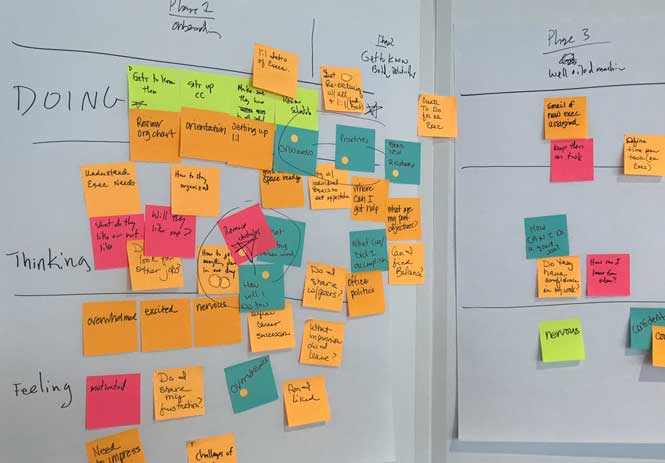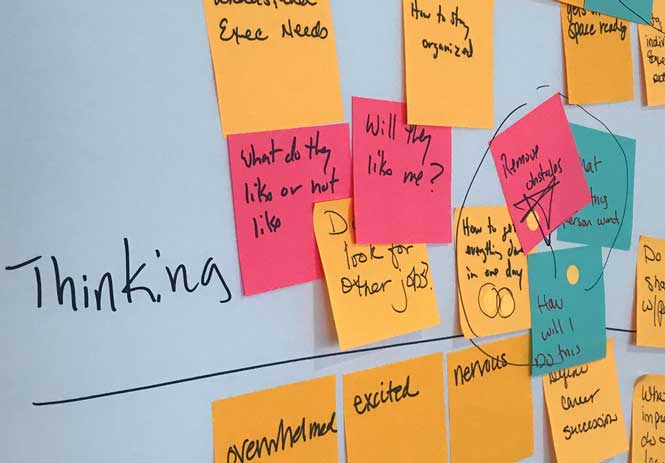As-Is Journey Maps
As-Is Journey Maps capture the actions, emotions, and decisions of a current member or employee experience, over time, so teams can identify opportunities for improvements or innovation.
As-Is Journey Maps represent what people actually experience, not the ideal state of a product or interaction. This way, the As-Is Journey Map can guide a team as they plan new experiences or revisions of existing experiences based on breakdowns, inefficiencies, pain points, or gaps.
You can use As-Is Journey Maps to:
- Expose pain points, opportunity areas, and moments that matter to the member or employee.
- Align and focus a team on real, rather than imagined needs.
- Develop a shared perspective on an experience from the member or employee point of view.
Prerequisites
A team can create As-Is Journey Maps once they have:
- Insight into what a member or employee does, thinks, and feels as they take an action in the current experience. This insight comes from conducting primary or secondary design research, observing people using your experience, or trying out the experience for yourself.
- Team agreement on the scope and focus of your journey mapping work. You agree to focus on a particular journey. And you agree on the depth and breadth of your scope. Your scope can be narrow (mobile payment) or wide (end-to-end life-cycle of opening, using, and closing a bank account); short (mobile check deposit) or long (successfully applying for and then paying off a 30-year mortgage).
This Is What It Looks Like



Template Downloads
Let’s Get Started
1 Identify the person (target member or employee) and the journey you will map.
Write a simple statement that describes the goal of the journey from the member or employee’s point of view. Tip: If you asked this target user “What are you trying to accomplish?” what would they say?
2 Identify steps in the journey.
Identify a starting point. Write out each key step in the journey on an individual sticky note. A step is a discrete activity such as an interaction with another person, a machine, or digital interface. Place your sticky notes in chronological order in the “Doing” swim lane.
Bonus Points
Include as much detail as you can about what the member or employee is doing, including passive activities like waiting.
3 Capture what a person might be thinking and feeling during each step.
Write one thought or feeling per sticky note. Place the sticky notes in the “Thinking” or “Feeling” swim lane, aligned under the relevant “Doing” step. You may find that this step is harder to do. That’s okay. Filling in this part of the journey map requires making some educated guesses about people’s cognitive process and emotional state.
Bonus Points
Validate the As-Is Journey Map with target members or employees. Have them correct your work. For example: “I’m not actually angry at this step, just confused. I don’t know where to find answers.” Member validation will make your map more accurate.
4 Identify broad phases.
Round out the journey map by summarizing the steps into key phases of the journey. A phase contains multiple steps, and provides insight into what is happening at a high-level across the journey. Phases also help surface any important pieces missing from your journey map.
For example, "Complete Application" is a phase. Doing steps in that phase could be "login", "access digital form", or "locate relevant personal documents needed to complete form".
Watch Out
Are there moments where you are unsure about what a user is doing, thinking, or feeling? Review your journey map to identify forgotten steps.
5 Circle the most pressing pain points + most impactful opportunity areas.
Circle the biggest pain points or areas in need of improvement. We call these “hot spots.” Here are some common situations that create hot spots:
- Is there a phase where a user is “doing” a lot—repetitive tasks with USAA or a lot of work outside our experience to accomplish their goal with us?
- Is there an area of the map where users are doing a lot of thinking and wondering? Are they uncertain or confused at inconvenient moments for them?
- Are there any misplaced emotions? Is a user feeling unsure, when they should be feeling confident about buying a product or opting into a service?
Vote as a team on the areas you think will, if addressed, have the most impact on your target members or employees. You'll use these pain points and opportunities to generate Idea Vignettes and future solutions. The As-Is Journey Map can also be played back to your team and in order to create a shared perspective of the problems your target members face.
Next Steps
See how teams are leveraging journey maps on a variety of projects at different fidelity levels at USAA